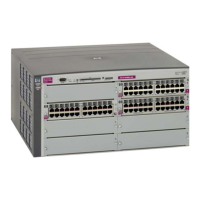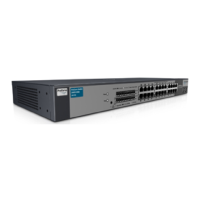OSPF 112
Interface cost
The OSPF link-state algorithm (Dijkstra’s algorithm) places each routing device at the root of a tree and determines the
cumulative cost required to reach each destination. Usually, the cost is inversely proportional to the bandwidth of the
interface. Low cost indicates high bandwidth. You can manually enter the cost for the output route with the following
command:
>> # /cfg/l3/ospf/if <OSPF interface number>/cost <cost value (1-65535)>
Electing the designated router and backup
In any area with more than two routing devices, a Designated Router (DR) is elected as the central contact for
database exchanges among neighbors, and a Backup Designated Router (BDR) is elected in case the DR fails.
DR and BDR elections are made through the hello process. The election can be influenced by assigning a priority
value to the OSPF interfaces on the switch. The command is as follows:
>>#/cfg/l3/ospf/if <OSPF interface number>/prio <priority value (0-255)>
A priority value of 255 is the highest, and 1 is the lowest. A priority value of 0 specifies that the interface cannot be
used as a DR or BDR. In case of a tie, the routing device with the lowest router ID wins.
Summarizing routes
Route summarization condenses routing information. Without summarization, each routing device in an OSPF
network would retain a route to every subnet in the network. With summarization, routing devices can reduce some
sets of routes to a single advertisement, reducing both the load on the routing device and the perceived complexity of
the network. The importance of route summarization increases with network size.
Summary routes can be defined for up to 16 IP address ranges using the following command:
>> # /cfg/l3/ospf/range <range number>/addr <IP address>/mask <mask>
where <range number> is a number 1 to 16, <IP address> is the base IP address for the range, and <mask> is
the IP address mask for the range.
Default routes
When an OSPF routing device encounters traffic for a destination address it does not recognize, it forwards that
traffic along the default route. Typically, the default route leads upstream toward the backbone until it reaches the
intended area or an external router.
Each switch acting as an ABR automatically inserts a default route into each attached area. In simple OSPF stub areas
or NSSAs with only one ABR leading upstream (see Area 1 in the figure below), any traffic for IP address destinations
outside the area is forwarded to the switch’s IP interface, and then into the connected transit area (usually the
backbone). Since this is automatic, no further configuration is required for such areas.
